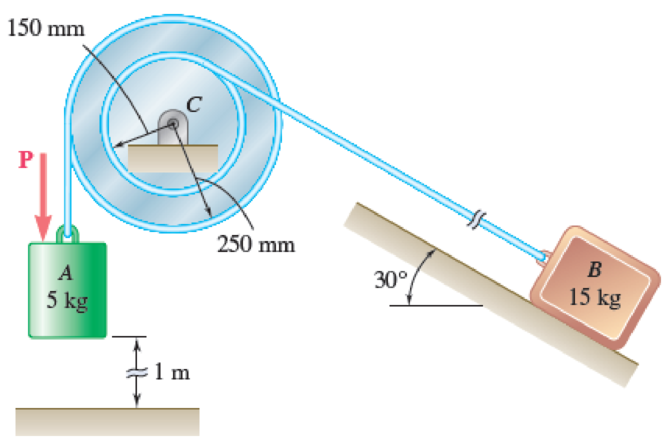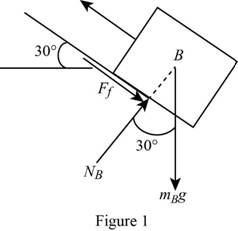
Concept explainers
The double pulley shown has a mass of 15 kg and a centroidal radius of gyration of 160 mm. Cylinder A and block B are attached to cords that are wrapped on the pulleys as shown. The coefficient of kinetic friction between block B and the surface is 0.2. Knowing that the system is at rest in the position shown when a constant force P = 200 N is applied to cylinder A, determine (a) the velocity of cylinder A as it strikes the ground, (b) the total distance that block B moves before coming to rest.

Fig. P17.14
(a)
Find the velocity of cylinder A as it strikes the ground.
Answer to Problem 17.14P
The velocity of the cylinder A when it strikes the ground is
Explanation of Solution
Given information:
The mass of the cylinder A is
The mass of the block B is
The radius of the outer pulley is
The radius of the inner pulley is
The centroidal radius of gyration is
The coefficient of friction between the surface and the block B is
The constant force applied at cylinder A is
Calculation:
Consider the acceleration due to gravity is
Consider the radius of the outer pulley as
Consider the radius of the inner pulley as
Find the velocity in the outer pulley
Here, the angular velocity of the pulley is
Find the velocity in the inner pulley
Substitute
Find the distance of the outer pulley
Here, the number of revolutions in the pulley C is
Find the distance of the inner pulley
Substitute
The initial total kinetic energy at rest is zero.
Find the mass moment of inertia in the pulley C
Here, the mass in the pulley C is
Substitute 15 kg for
Find the total kinetic energy
Substitute 5 kg for
Substitute 250 mm for
When
Substitute 150 mm for
Show free-body diagram the block B as in Figure 1.

Resolve the vertical component of forces as follows;
Find the frictional force
Substitute 0.20 for
Apply the principle of work and energy for the cylinder A, the block B and the double pulley C as follows;
Substitute 200 N for P, 1 m for
Write the equation of work and energy for the system using the equation.
Substitute 0 for
Therefore, the velocity of the cylinder A when it strikes the ground is
(b)
Find the total distance the block B moves before coming to rest.
Answer to Problem 17.14P
The total distance travelled by the block B before coming to rest is
Explanation of Solution
Given information:
The mass of the cylinder A is
The mass of the block B is
The radius of the outer pulley is
The radius of the inner pulley is
The centroidal radius of gyration is
The coefficient of friction between the surface and the block B is
The constant force applied at cylinder A is
Calculation:
Refer part (a) for
Substitute
Substitute 150 mm for
Find the total kinetic energy
Substitute 5 kg for
At the final position, the system comes at rest.
The kinetic energy at rest is zero.
Apply the principle of work and energy for the block B as follows;
Here, the additional distance travelled by the block is
Substitute
Write the equation of work and energy for the system using the equation.
Substitute 132.3066 J for
Find the total distance
Substitute 0.6 m for
Therefore, the total distance travelled by the block B before coming to rest is
Want to see more full solutions like this?
Chapter 17 Solutions
Vector Mechanics for Engineers: Statics and Dynamics
Additional Engineering Textbook Solutions
Vector Mechanics For Engineers
Concepts Of Programming Languages
Thermodynamics: An Engineering Approach
Modern Database Management
Electric Circuits. (11th Edition)
Starting Out with C++ from Control Structures to Objects (9th Edition)
- 1. Two long rods of the same diameter-one made of brass (k=85w/m.k) and the other made of copper (k=375 w/m.k) have one of their ends inserted into a furnace (as shown in the following figure). Both rods are exposed to the same environment. At a distance of 105 mm from the furnace, the temperature of the brass rod is 120°C. At what distance from the furnace will the same temperature be reached in the copper rod? Furnace 105 mm T₁ Brass rod ⑪ h Too- x2- Ti Copper rodarrow_forward: +0 العنوان use only Two rods fins) having same dimensions, one made orass (k = 85 Wm K) and the mer of copper (k = 375 W/m K), having of their ends inserted into a furna. At a section 10.5 cm a way from furnace, the temperature of brass rod 120 Find the distance at which the ame temperature would be reached in the per rod ? both ends are ex osed to the same environment. ns 2.05 ۲/۱ ostrararrow_forwardمشر on ۲/۱ Two rods (fins) having same dimensions, one made of brass(k=85 m K) and the other of copper (k = 375 W/m K), having one of their ends inserted into a furnace. At a section 10.5 cm a way from the furnace, the temperature brass rod 120°C. Find the distance at which the same temperature would be reached in the copper rod ? both ends are exposed to the same environment. 22.05 ofthearrow_forward
- The composite wall of oven with A= 1m² as in Fig.1 consists of three materials, two of with kA = 20 W/m K and kc = 50 W/m K with thickness, LA=0.3 m, L= 0.15 m and Lc 0.15 m. The inner surface temperature T1=900 K and the outer surface temperature T4 300 K, and an oven air temperature of To=1100 K, h=25 W/m². K. Determine kɛ and the temperatures T2 and T3 also draw the thermal resistance networkarrow_forwardTwo rods (fins) having same dimensions, one made of brass (k = 85 Wm K) and the other of copper (k = 375 W/m K), having one of their ends inserted into a furnace. At a section 10.5 cm a way from the furnace, the temperature of brass rod 120°C. Find the distance at which the same temperature would be reached in the copper rod ? both ends are exposed to the same environment. Ans 22.05arrow_forwardA long wire (k-8 W/m °C.) with ro 5 mm and surface temperature Ts=180°C as shown in Fig.2. Heat is generated in the wire uniformly at a rate of 5 x107 W/m³. If the energy equation is given by: d 11(77) + - =0 k r dr dr Derive an expression for T(r) and determine the temperature at the center of the wire and at r=2 mm. Air Th T KA LA T2 T3 T Fig.1 KB kc 180°C Го Fig.2arrow_forward
- B: Find the numerical solution for the 2D equation below and calculate the temperature values for each grid point shown in Fig. 2 (show all steps). (Do only one trail using following initial values and show the final matrix) T₂ 0 T3 0 I need a real solution, not artificial intelligence locarrow_forwardCan I solve this problem by calculating the initial kinetic energy with respect to G instead of A.arrow_forwardB: Find the numerical solution for the 2D equation below and calculate the temperature values for each grid point shown in Fig. 2 (show all steps). (Do only one trail using following initial values and show the final matrix) T₂ 0 T3 0 locarrow_forward
- Show all work. Indicate the origin that is used for each plane. Identify the Miller indices for the following planes. N 23 1 A) X B) yarrow_forwardthe following table gives weight gain time data for the oxidation of some metal at an elevated temperature W(mg/cm2). Time (min) 4.66 20 11.7 50 41.1 175 a) determin whether the oxidation kinetics obey a linear, parabolic, or logarithmic rate expression. b) Now compute W after a time of 1000 minarrow_forwardA cylindrical specimen of aluminum is pulled in tension. Use the stress v. strain plot below for this specimen of Al to answer parts (a) - (f). Hint: Each strain increment is 0.004. Be sure to include your engineering problem solving method per the class rubric. 400 350 300 250 Stress (MPa) 200 150 100 50 Aluminum (Stress v. Strain) 0 0 0.02 0.04 0.06 0.08 Strain 0.1 0.12 0.14 0.16 a. Compute the modulus of elasticity. b. Determine the yield strength at a strain offset of 0.002. c. Determine the tensile strength of this metal. d. Compute the ductility in percent elongation. e. Compute the modulus of resilience. f. Determine the elastic strain recovery for an unloaded stress of 340 MPa.arrow_forward
 Elements Of ElectromagneticsMechanical EngineeringISBN:9780190698614Author:Sadiku, Matthew N. O.Publisher:Oxford University Press
Elements Of ElectromagneticsMechanical EngineeringISBN:9780190698614Author:Sadiku, Matthew N. O.Publisher:Oxford University Press Mechanics of Materials (10th Edition)Mechanical EngineeringISBN:9780134319650Author:Russell C. HibbelerPublisher:PEARSON
Mechanics of Materials (10th Edition)Mechanical EngineeringISBN:9780134319650Author:Russell C. HibbelerPublisher:PEARSON Thermodynamics: An Engineering ApproachMechanical EngineeringISBN:9781259822674Author:Yunus A. Cengel Dr., Michael A. BolesPublisher:McGraw-Hill Education
Thermodynamics: An Engineering ApproachMechanical EngineeringISBN:9781259822674Author:Yunus A. Cengel Dr., Michael A. BolesPublisher:McGraw-Hill Education Control Systems EngineeringMechanical EngineeringISBN:9781118170519Author:Norman S. NisePublisher:WILEY
Control Systems EngineeringMechanical EngineeringISBN:9781118170519Author:Norman S. NisePublisher:WILEY Mechanics of Materials (MindTap Course List)Mechanical EngineeringISBN:9781337093347Author:Barry J. Goodno, James M. GerePublisher:Cengage Learning
Mechanics of Materials (MindTap Course List)Mechanical EngineeringISBN:9781337093347Author:Barry J. Goodno, James M. GerePublisher:Cengage Learning Engineering Mechanics: StaticsMechanical EngineeringISBN:9781118807330Author:James L. Meriam, L. G. Kraige, J. N. BoltonPublisher:WILEY
Engineering Mechanics: StaticsMechanical EngineeringISBN:9781118807330Author:James L. Meriam, L. G. Kraige, J. N. BoltonPublisher:WILEY





